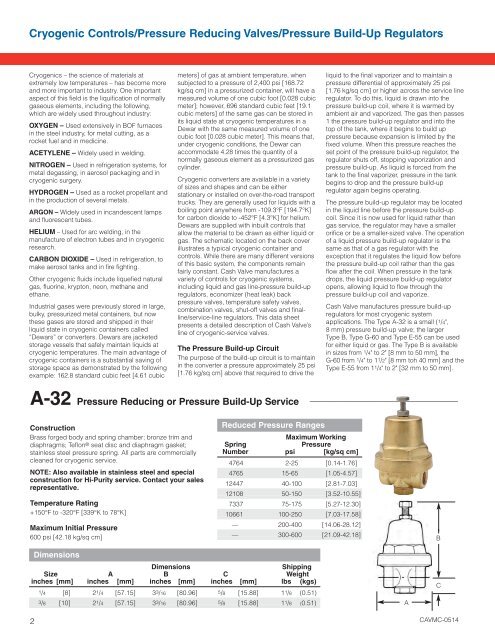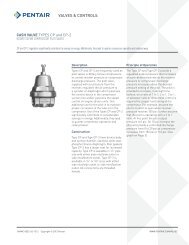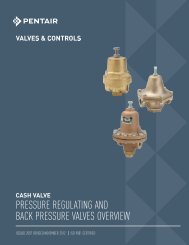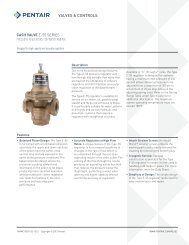Cryogenic Controls PDF (CAVMC-0514 - Cash Valve
Cryogenic Controls PDF (CAVMC-0514 - Cash Valve
Cryogenic Controls PDF (CAVMC-0514 - Cash Valve
Create successful ePaper yourself
Turn your PDF publications into a flip-book with our unique Google optimized e-Paper software.
<strong>Cryogenic</strong> <strong>Controls</strong>/Pressure Reducing <strong>Valve</strong>s/Pressure Build-Up Regulators<br />
<strong>Cryogenic</strong>s – the science of materials at<br />
extremely low temperatures – has become more<br />
and more important to industry. One important<br />
aspect of this field is the liquification of normally<br />
gaseous elements, including the following,<br />
which are widely used throughout industry:<br />
OXYGEN – Used extensively in BOF furnaces<br />
in the steel industry, for metal cutting, as a<br />
rocket fuel and in medicine.<br />
ACETYLENE – Widely used in welding.<br />
NITROGEN – Used in refrigeration systems, for<br />
metal degassing, in aerosol packaging and in<br />
cryogenic surgery.<br />
HYDROGEN – Used as a rocket propellant and<br />
in the production of several metals.<br />
ARGON – Widely used in incandescent lamps<br />
and fluorescent tubes.<br />
HELIUM – Used for arc welding, in the<br />
manufacture of electron tubes and in cryogenic<br />
research.<br />
CARBON DIOXIDE – Used in refrigeration, to<br />
make aerosol tanks and in fire fighting.<br />
Other cryogenic fluids include liquefied natural<br />
gas, fluorine, krypton, neon, methane and<br />
ethane.<br />
Industrial gases were previously stored in large,<br />
bulky, pressurized metal containers, but now<br />
these gases are stored and shipped in their<br />
liquid state in cryogenic containers called<br />
“Dewars” or converters. Dewars are jacketed<br />
storage vessels that safely maintain liquids at<br />
cryogenic temperatures. The main advantage of<br />
cryogenic containers is a substantial saving of<br />
storage space as demonstrated by the following<br />
example: 162.8 standard cubic feet [4.61 cubic<br />
Construction<br />
Brass forged body and spring chamber; bronze trim and<br />
diaphragms; Teflon® seat disc and diaphragm gasket;<br />
stainless steel pressure spring. All parts are commercially<br />
cleaned for cryogenic service.<br />
NOTE: Also available in stainless steel and special<br />
construction for Hi-Purity service. Contact your sales<br />
representative.<br />
Temperature Rating<br />
+150°F to -320°F [339°K to 78°K]<br />
Maximum Initial Pressure<br />
600 psi [42.18 kg/sq cm]<br />
2<br />
meters] of gas at ambient temperature, when<br />
subjected to a pressure of 2,400 psi [168.72<br />
kg/sq cm] in a pressurized container, will have a<br />
measured volume of one cubic foot [0.028 cubic<br />
meter]; however, 696 standard cubic feet [19.1<br />
cubic meters] of the same gas can be stored in<br />
its liquid state at cryogenic temperatures in a<br />
Dewar with the same measured volume of one<br />
cubic foot [0.028 cubic meter]. This means that,<br />
under cryogenic conditions, the Dewar can<br />
accommodate 4.28 times the quantity of a<br />
normally gaseous element as a pressurized gas<br />
cylinder.<br />
<strong>Cryogenic</strong> converters are available in a variety<br />
of sizes and shapes and can be either<br />
stationary or installed on over-the-road transport<br />
trucks. They are generally used for liquids with a<br />
boiling point anywhere from -109.3°F [194.7°K]<br />
for carbon dioxide to -452°F [4.3°K] for helium.<br />
Dewars are supplied with inbuilt controls that<br />
allow the material to be drawn as either liquid or<br />
gas. The schematic located on the back cover<br />
illustrates a typical cryogenic container and<br />
controls. While there are many different versions<br />
of this basic system, the components remain<br />
fairly constant. <strong>Cash</strong> <strong>Valve</strong> manufactures a<br />
variety of controls for cryogenic systems,<br />
including liquid and gas line-pressure build-up<br />
regulators, economizer (heat leak) back<br />
pressure valves, temperature safety valves,<br />
combination valves, shut-off valves and finalline/service-line<br />
regulators. This data sheet<br />
presents a detailed description of <strong>Cash</strong> <strong>Valve</strong>’s<br />
line of cryogenic-service valves.<br />
The Pressure Build-up Circuit<br />
The purpose of the build-up circuit is to maintain<br />
in the converter a pressure approximately 25 psi<br />
[1.76 kg/sq cm] above that required to drive the<br />
liquid to the final vaporizer and to maintain a<br />
pressure differential of approximately 25 psi<br />
[1.76 kg/sq cm] or higher across the service line<br />
regulator. To do this, liquid is drawn into the<br />
pressure build-up coil, where it is warmed by<br />
ambient air and vaporized. The gas then passes<br />
1 the pressure build-up regulator and into the<br />
top of the tank, where it begins to build up<br />
pressure because expansion is limited by the<br />
fixed volume. When this pressure reaches the<br />
set point of the pressure build-up regulator, the<br />
regulator shuts off, stopping vaporization and<br />
pressure build-up. As liquid is forced from the<br />
tank to the final vaporizer, pressure in the tank<br />
begins to drop and the pressure build-up<br />
regulator again begins operating.<br />
The pressure build-up regulator may be located<br />
in the liquid line before the pressure build-up<br />
coil. Since it is now used for liquid rather than<br />
gas service, the regulator may have a smaller<br />
orifice or be a smaller-sized valve. The operation<br />
of a liquid pressure build-up regulator is the<br />
same as that of a gas regulator with the<br />
exception that it regulates the liquid flow before<br />
the pressure build-up coil rather than the gas<br />
flow after the coil. When pressure in the tank<br />
drops, the liquid pressure build-up regulator<br />
opens, allowing liquid to flow through the<br />
pressure build-up coil and vaporize.<br />
<strong>Cash</strong> <strong>Valve</strong> manufactures pressure build-up<br />
regulators for most cryogenic system<br />
applications. The Type A-32 is a small (1/4",<br />
8 mm) pressure build-up valve; the larger<br />
Type B, Type G-60 and Type E-55 can be used<br />
for either liquid or gas. The Type B is available<br />
in sizes from 1/4" to 2" [8 mm to 50 mm], the<br />
G-60 from 1/4" to 11/2" [8 mm toh 40 mm] and the<br />
Type E-55 from 11/4" to 2" [32 mm to 50 mm].<br />
A-32 Pressure Reducing or Pressure Build-Up Service ____________________________<br />
Reduced Pressure Ranges<br />
Maximum Working<br />
Spring Pressure<br />
Number psi [kg/sq cm]<br />
4764 2-25 [0.14-1.76]<br />
4765 15-65 [1.05-4.57]<br />
12447 40-100 [2.81-7.03]<br />
12108 50-150 [3.52-10.55]<br />
7337 75-175 [5.27-12.30]<br />
10661 100-250 [7.03-17.58]<br />
— 200-400 [14.06-28.12]<br />
— 300-600 [21.09-42.18]<br />
Dimensions<br />
Dimensions Shipping<br />
Size A B C Weight<br />
inches [mm] inches [mm] inches [mm] inches [mm] lbs (kgs)<br />
1/4 [8] 21/4 [57.15] 33/16 [80.96] 5/8 [15.88] 11/8 (0.51)<br />
3/8 [10] 21/4 [57.15] 33/16 [80.96] 5/8 [15.88] 11/8 (0.51)<br />
A<br />
B<br />
C<br />
<strong>CAVMC</strong>-<strong>0514</strong>






